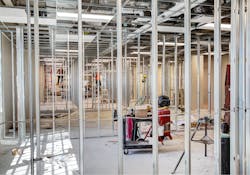How to Reduce Lost Labor Hours on Electrical Construction Projects
More than 711,000 people currently work in the electrical industry, according to the U.S. Department of Labor — or they should be working. Instead, they often spend a lot of time standing around waiting for materials, equipment, colleagues, and even customers to show up so they can do their jobs. Exactly how much time? Sometimes more than half of an electrician’s workday is unproductive, according to contractors and consultants who have analyzed the problem of lost labor hours.
“They probably only spend 40% to 45% of their time installing, so there’s 60% to 55% waste,” says Jamie Sullivan, president of Milwaukee-based Staff Electric.
“We used to get 95% of our material from one supply house,” says Rich Shumway, field supervisor at Hyattsville, Md.-based Wilcox Electric. “Now we probably get 75% from that supply house and the other 25% comes from three other supply houses, Amazon, Lowe’s, Home Depot, or websites. When our supply houses don’t have material we need, we often find the material in stock at home improvement stores. We have to take more time now to search for material or alternative solutions for material that was readily available before the pandemic.”
Some electrical contractors are mitigating that problem by using prefab, which does more than just ensure that the right materials are in the right place at the right time.
“It also requires pre-planning,” says Neil Davidson, executive vice president at Lincoln, Neb.-based Commonwealth Electric Company of the Midwest. “So, it forces us to plan ahead and look at things instead of being reactive on the job site. We’re looking way ahead ordering material, putting the parts and pieces together, and getting them out there at the right time. It does a lot of things to increase production on a job site.”
Fail to plan? Plan to fail
A detailed, organized estimate can go a long way toward minimizing lost labor hours.
“One purpose of an estimate is to provide a detailed, organized plan to execute the project profitably,” says Don Kiper, an independent electrical estimating trainer and consultant based in Niagara Falls, N.Y. “Most contractors fail right there.”
The more thorough the plan, the more likely electricians are to have everything they need — not only materials, but also tools, forklifts, dumpsters, and even a crew to stage materials and collect trash.
“I feel that the biggest factor is not having a plan and working to that plan,” Sullivan says. “In a truly utopian world, if an electrician is working on the 18th floor and gets here at 7 a.m., he would have his drawings in front of him. He would have all his material. All he would have to do is install it.”
To get as close to that utopia as possible, Staff scrutinizes each project using processes designed to ferret out waste and inefficiency.
“As an example, we've been doing JPAC™ (job productivity assurance and control), SIS™ (short-interval scheduling), and WBS™ (work breakdown structure) for six years,” Sullivan says.“You can actually see how our productivity has increased per electrician. If the average is $270,000 or $250,000 per electrician, our average is now $350,000 to $370,000. I believe they’re not working harder. They’re just working smarter.
“An electrician wants to build. How do we get the material to his point of install? How do we get it so that he doesn’t have to worry about the garbage or unboxing light fixtures?”
Some productivity busters are due to traditional ways of assessing progress.
“The risk is passed on to the field versus managed by the company,” says Dr. Perry Daneshgari, president and CEO of MCA, Inc., a Grand Blanc, Mich.-based consultancy whose clients include Staff Electric. “Companies measure the progress of the jobs financially only, not by the way the job is being done. So the work and labor are not being managed, and that ends up in labor overrun.”
Daneshgari maintains labor overrun has historically been a disease in the construction industry. “Since it's not measured, it's not managed,” he says.
Another factor that can squelch productivity is busy work that doesn’t move the progress needle much. The reason is ironic, considering the electrical industry has a chronic shortage of people.
“The priority of the people in the job site is to make sure people are busy — in other words, so they don't get laid off,” Daneshgari says. “The labor get paid as long as they show up, but the company doesn't get paid as long as they show up. The company gets paid when they perform.”
Daneshgari likens this to project managers horse trading. “They take the money that they may have in their slush funds or unused money in their fixtures-and-gear budget and let the labor use it.”
Fixing the problem without fixing the blame
Finger pointing between project managers and estimators is common when a project winds up taking longer than it was supposed to.
“There’s a famine in the land for quality skilled estimators because the company culture at most places is that as soon as the job starts going south and losing money, everybody immediately wants to pounce on the estimator,” says Kiper, who explored this problem in an October 2019 EC&M column, “The Estimator vs. the Project Manager.”
Finger pointing can lead to even bigger problems down the road if it creates a culture where project managers, estimators, and others instinctively limit their feedback simply to avoid conflict. The result is fewer opportunities to learn from mistakes — theirs and their colleagues’.
“We’re trying to drive a different culture,” says Nicholas Hlavinka, Staff Electric executive vice president. “We don’t want blame. We want feedback. Everyone knows that our estimating department is not afraid of feedback as long as they come with a positive attitude. We also have a lot of project managers who used to estimate, so they understand that sheet notes can be missed, and details and specs are overlooked.”
Who’s on the job site?
Electrical isn’t the only trade struggling with a shortage of skills and supplies these days. That situation only exacerbates the longstanding challenge of trade stacking, where electricians are tripping over or waiting on the plumbers, carpenters, and HVAC techs who were supposed to have cleared out days or weeks before.
“There’s always somebody that doesn’t have something that they need, so you’re working around that issue,” says Commonwealth’s Davidson. “They either don’t have enough people to get their material installed, or they can’t get XYZ part that needs to go into the puzzle. So, you have to work around and then come back.”
Two other factors are the number of apprentices on a job and their relationships with the electricians, journeymen, and foremen on a particular project.
“Maximizing the apprentices on the job site is key to help combat the shortage of skilled labor,” Davidson says. “The electricians and foreman need to know the apprentices’ skills to get the most out of them. Preplanning and proper management of apprentices is the key to success when using a higher ratio of apprentices to skilled electricians.”
Shumway agrees: “We have nine electricians and six apprentices right now, and the apprentices work with all the electricians. The electricians need to know the apprentices’ skills and get the most out of them.”
Navigating the residential market
Scheduling is key for maximizing productivity, but it’s particularly tricky in the residential arena.
“Our guys often do multiple service calls or estimates in a day,” Shumway says. “That can be a lot of drive time in D.C. traffic. Traffic decreased a lot during the pandemic but has picked back up. We try to schedule our electricians’ days to minimize drive time, but sometimes it is unavoidable. There are some route optimization software [applications] out there, but we do not use one.”
Cancellations and postponements are longstanding challenges in the residential market as well.
“We are having cancellations or postponements on a daily basis, so we’re scrambling to find jobs to move up on a daily basis,” Shumway says. “We [recently] had eight same-day cancellations. That’s out of probably 40 jobs. That’s crazy.”
“We’re still seeing a lot of it,” Shumway says.
Vehicle maintenance also directly affects productivity and profitability.
“If we need to get an electrician’s vehicle worked on, we have to pay them to transfer his tools/some material to a spare van, pay two men to drop it off, pay two men to pick it up, and pay the electrician to transfer it back into their van,” Shumway says. “On top of that, we lost the revenue the electrician would have made had he been doing electrical work. We’ve found keeping a new fleet cuts down on this time and keeps maintenance bills down.”
But supply chain shortages are a problem there, too.
“The pandemic created a vehicle shortage, and replacing our vehicles became much more expensive,” Shumway says. “Also, most of our guys prefer the smaller vans due to D.C. parking. But as of right now, after 2023, no manufacturers are planning to sell a small work van in the U.S. market.”
Leveraging technology to minimize downtime
Some contractors, large and small, use cellular telematics services to track each vehicle’s location and health. For example, the onboard module can send alerts when oil pressure, temperature, and other metrics go beyond recommended parameters.
One way that telematics services can help minimize lost labor hours is by identifying emerging problems so that vehicle can go into the shop the next day. That heads off a breakdown that would leave the electrician on the side of the road for a few hours.
Some contractors use telematics services not only for vehicles, but also for other high-value mobile assets such as equipment trailers, skid steers, and forklifts. One main reason is theft: They can get alerts when an asset moves outside a geofenced area and then tell law enforcement where it is to enable recovery. Another reason is identifying and retasking equipment that’s sitting idle because a particular project no longer needs it.
Those location-based capabilities also can be used to ensure that all of the right equipment will be on site when electricians arrive. And if some of it isn’t, supervisors and foreman can quickly check to see if there are any nearby jobs that aren’t using that equipment.
In fact, some contractors see the most business value in using telematics to maximize productivity rather than thwarting theft. For example, one of MCA’s clients has tools ranging from $250,000 to $750,000 apiece.
“If they can save one hour of the labor not moving material, that’s $1.2 million,” Daneshgari says. “When the owner looks at it, he says: ‘I don’t care about the tools. I do care about the labor losses.’”
On large, complex projects, another helpful technology is robotic total stations.
“Our engineers lay out points, whether it be hangers for conduit, floor boxes, or core drills,” says Commonwealth’s Davidson. “Those will be loaded into the computer and then transposed into the robotic unit. Then we go out in the field, set that up, and mark those points out on the floor or the ceiling. In the old days, you’d be out there with the tape measure and some strings. Now you can shoot hundreds of points in an hour. That’s really helped our efficiency in the field.”
Tim Kridel is an independent analyst and freelance writer. He can be reached at [email protected].






